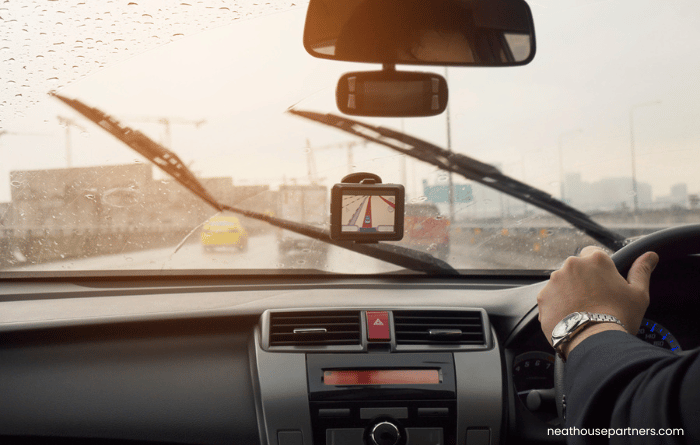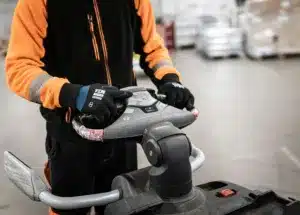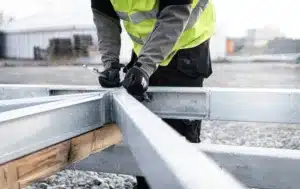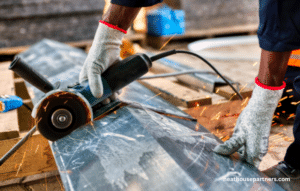As the winter draws in, the weather significantly impacts our working lives – (and we love talking about it!!).
In the UK, when it rains, it pours, and wet weather can quickly become a hazard to health and safety, irrespective of what sector you work in.
One of the main risks to health and safety for employers is while employees are travelling, either long/short distances or on-site, including when we travel on foot.
In the UK, your employer is responsible for conducting a risk assessment for the task and providing suitable controls that should prevent this risk from developing into an incident or accident when your travel is considered to be for work-related purposes other than commuting (such as visiting sites, using a vehicle on a site, or making deliveries, for example).
Travelling In Wet Weather
Any employer whose employees drive for work should consider rain, storms, sleet, snow, ice and any other sort of adverse weather because (especially in the UK), the weather can be unpredictable and raise risks, such as.
Visibility
Rain can significantly limit visibility, making it more difficult to see any roadways, other vehicles, or workers/pedestrians in the area, whether operating a car, crane, or excavator.
Depending on the situation, you might not notice someone or something until it’s too late to stop.
Road surface and stopping distance – Every driver should be aware that heavy rain and the resulting pools of water will significantly lengthen the stopping distance of their car.
In rainy conditions, the stopping distance doubles, resulting in a stopping distance of up to 146m at 60 mph.
Aquaplaning/Hydroplaning
This happens when hitting a pool of standing water on a road while driving.
If you’ve ever experienced this, you know it is frightening.
This is due to the vehicle’s speed, and the depth of the pool.
The water on the road surface gets under the tyre rather than separating around it or dispersing via gaps in the tread, causing your car to practically start water-skiing.
Aquaplaning makes steering near impossible, and you are at a high risk of a collision.
To reduce the risk of aquaplaning, you must ensure that all tyres are in good condition, with sufficient tread and that you pass through water slowly.
If employees are required to drive for work; whether it is a company vehicle, hired vehicle or personal car, employers should ensure all vehicles have routine maintenance checks to help identify issues before they become a problem.
In terms of wet weather, there should be a consideration for:
- Tyre condition and tread depth
- The condition of the brakes
- Ensuring bulbs work
- Any equipment used in emergencies
- Windscreen wipers and wiper fluid
This includes relevant tasks such as regular maintenance related to the specific use of the vehicle.
A good example of this would be checking the for any damage or cracks on your windscreen.
If you discover damage, you should get it replaced or repaired ASAP.
Whilst we don’t all keep our cars spotlessly clean, you must keep your windows clean to ensure you have the best visibility.
Also, remember not to use boiling water to defrost your windscreen in the winter months – this will likely lead to your windscreen cracking!
Travelling by foot
Travelling on foot in wet conditions comes with many of the same risks as travelling in a vehicle.
If you’re travelling on foot in the rain and have the misfortune of being struck by a moving vehicle, the consequences are often life-changing or fatal.
Vehicles are very durable, the human body doesn’t have internal airbags or a crumple zone.
Key things to remember when travelling by foot:
Staying visible – Heavy rainfall, fog or thick cloud cover can reduce visibility significantly.
It’s essential that if you are working in low visibility conditions, measures are taken to ensure that you can be easily seen so that other people can identify that there is a worker/pedestrian in the vicinity.
This may mean high visibility clothing or ensuring that working areas are well-lit by floodlights, standing lights, streetlights or behind barriers.
Staying on your feet – Water itself and mud/slick surfaces that can pose a higher risk to frequent slips and falls can be especially problematic when you are regularly changing surfaces e.g., muddy boots on tarmac or wet shoes indoors.
Slips and falls from any height commonly result in bruises, sprains, and sometimes broken bones.
Additionally, if you’re working at height or with equipment, you could slip over/under safety barriers, or drop the equipment that you are carrying/using, which can lead to damaging results.
Shoe Tread – it is important that any worker who is likely to be working in wet/cold weather conditions is provided with appropriate footwear to reduce the likelihood of a slip or fall.
Shoes with worn-down or no tread can be a greater influencing factor in slips, trips and falls.
Wet and decaying leaves – Falling autumn leaves bring us into the winter months.
Beautiful as it may seem, if left to decay on the ground on paths or hard surfaces, they create a risk in themselves as they can hide any hazards and create a slip risk.
Putting in place a procedure for removing leaves at regular intervals throughout this period of the year will aid in reducing unnecessary accidents or incidents while walking on foot.
Personal Protection Equipment – PPE
If working or travelling in wet/cold weather isn’t mentally taxing enough, water will always flow the easiest possible route no matter the surface it falls on.
If a person is poorly equipped with improper PPE in adverse weather conditions, they soon become soaked and demoralised with any task on hand.
Short-term problems arise, such as reduced dexterity in the hands, leading to tasks taking longer to undertake and further exposing the person to cold and wet conditions.
The same is true for waterlogged boots/shoes as this presents a real problem of potential trench foot if they are not correctly dried out and socks are not changed frequently.
All employers have a legal duty to ensure that all PPE is appropriate for the job and task on hand.
If cold and wet weather is sealed out of the employee, they can perform at their best and know their employer is acting in their best interest to take care of them, leading to a proactive workforce.
Employers should lead by example with clear and concise instructions while always looking for the tell-tale signs of cold and wet unproductive employees.
How Neathouse Partners Can Assist
Here at Neathouse Partners, we have years of specialist experience in dealing with all aspects of Health and Safety.
We offer advice and updates, providing your company with your own dedicated Health and Safety Consultant so that you can be confident that all of your bespoke documentation and processes are aligned with your operations.
These include Policies, Fire Safety, Risk Assessments, Method Statements and much more.
Perfect for a business that needs to be compliant but just does not have the time or resources
For further advice or support, contact one of our experts today on 01244 893776.





